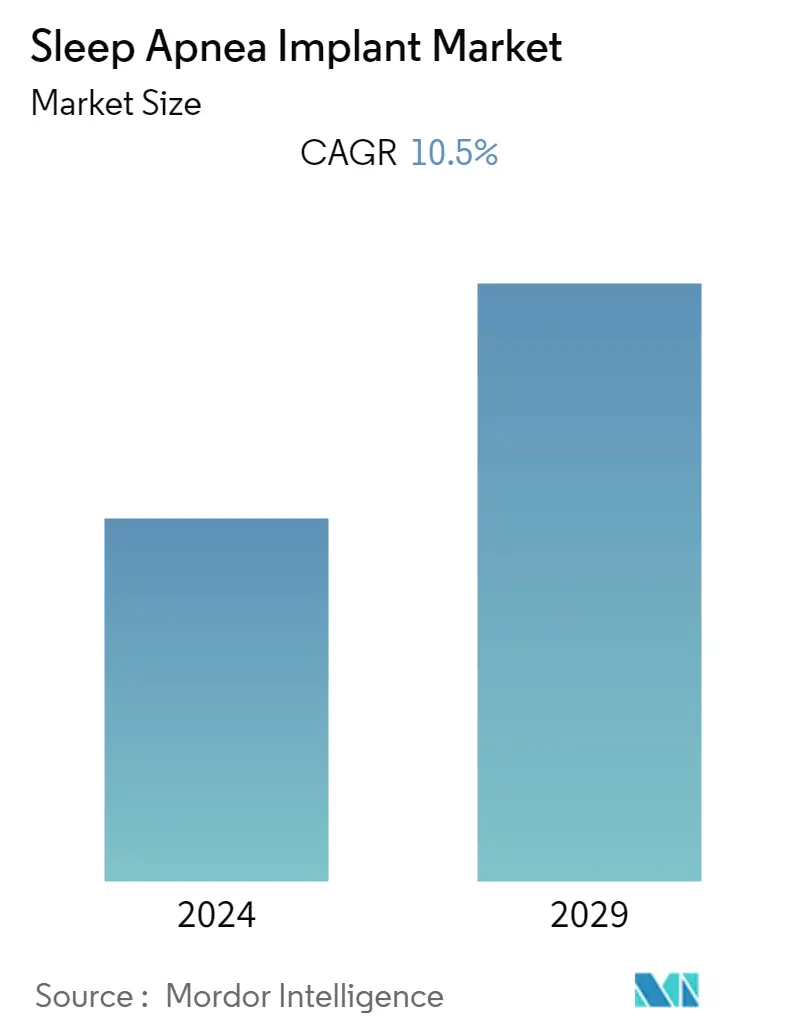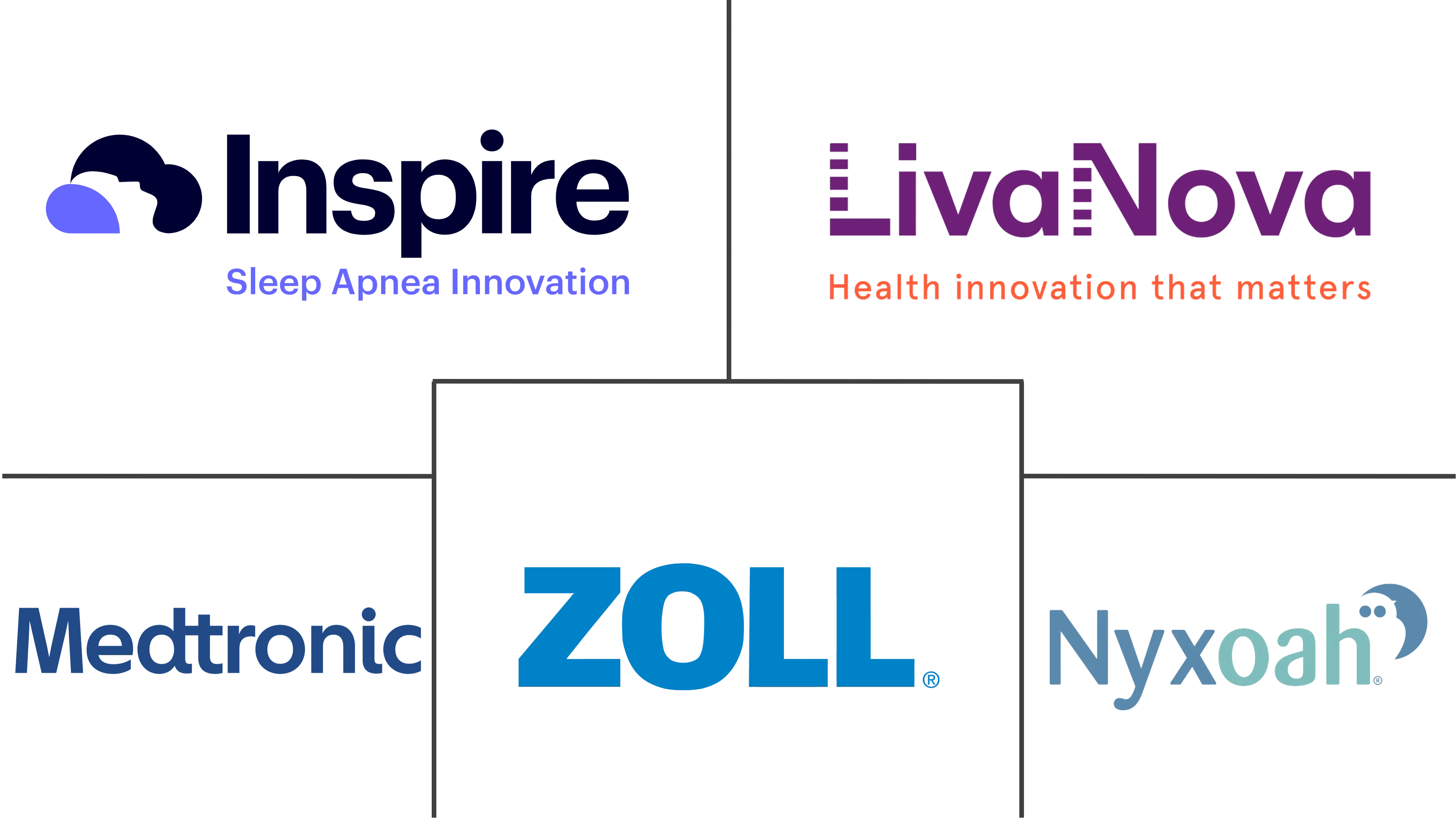Market Size of Sleep Apnea Implant Industry

| Study Period | 2019 - 2029 |
| Base Year For Estimation | 2023 |
| Forecast Data Period | 2024 - 2029 |
| CAGR | 10.50 % |
| Fastest Growing Market | Asia Pacific |
| Largest Market | North America |
Major Players
*Disclaimer: Major Players sorted in no particular order |
Sleep Apnea Implant Market Analysis
The sleep apnea implant market is expected to register a CAGR of 10.5% during the forecast period.
COVID-19 had a substantial impact on the sleep apnea implant market since patients with sleep apnea experienced worsening symptoms after affecting COVID-19. The infection promoted airway irritation, making sleep breathing more difficult. Such an important life event is likely to interrupt sleep and have an impact on market growth. For instance, as per the article published in February 2022 in ERJ journal, the researchers showed a significant correlation between increased prevalence and severity of sleep apnea during recovery from illness and the severity of SARS-CoV-2 infection. However, as the restrictions are lifted, and COVID-19 cases are reduced, the market is anticipated to witness growth in the coming years due to the increase in demand for sleep apnea implants, rapid technological advancements, and a rise in sleep disorders.
The growth of the sleep apnea implant market can be attributed to factors such as the rise in sleep disorders and technological advancements in sleep apnea implants. For instance, as per the Advisor 2023 update, about 70 million people in the United States suffer from sleep disorders. In addition, research studies demonstrating the technological advancements of sleep apnea implants are anticipated to boost market growth over the forecast period. For instance, as per the article published in February 2022 in PubMed, mini-implant assisted rapid palatal expansion (MARPE), which increased the size of the nasal and oral cavities and widens the midface, which helped in some patients with OSA therapy by reducing airflow resistance. Furthermore, in February 2022, LivaNova PLC marked its first investigational device exemption study, as the patient was implanted with the company's obstructive sleep apnea (OSA) treatment device. The company's randomized controlled study, 'Treating Obstructive Sleep Apnea using Targeted Hypoglossal Neurostimulation' (OSPREY), seeks to demonstrate the safety and effectiveness of the LivaNova aura6000 System, an implantable hypoglossal neurostimulator intended to treat adult patients with moderate to severe OSA.
Thus, due to the rise in sleep apnea cases and the surge in technological advancements in sleep apnea implants, the studied market is anticipated to witness growth over the forecast period. However, the high cost of sleep apnea implants is likely to restrain the market growth over the forecast period.
Sleep Apnea Implant Industry Segmentation
As per the scope of the report, a sleep apnea implant is an implantable device that stimulates the muscles of the tongue and upper airway during sleep. These implantable devices improve airflow. It's also called a hypoglossal nerve stimulator or upper airway stimulation device. The device is implanted in the upper right chest beneath the skin. The Sleep Apnea Implant Market is Segmented by Product Type (Hypoglossal Neurostimulation Devices, Phrenic Nerve Stimulator, and Palatal Implants), Indication Type (Obstructive Sleep Apnea, Central Sleep Apnea), End User (Hospitals, Ambulatory Surgical Centers), and Geography (North America, Europe, Asia-Pacific, Middle East and Africa, South America). The market report also covers the estimated market sizes and trends for 17 different countries across major regions globally. The report offers the value (in USD million) for the above segments.
| By Product Type | |
| Hypoglossal Neurostimulation Devices | |
| Phrenic Nerve Stimulator | |
| Palatal Implants |
| By Indication Type | |
| Obstructive Sleep Apnea | |
| Central Sleep Apnea |
| By End User | |
| Hospitals | |
| Ambulatory Surgical Centers | |
| Office Based Clinics |
| Geography | ||||||||
| ||||||||
| ||||||||
| ||||||||
| ||||||||
|
Sleep Apnea Implant Market Size Summary
The sleep apnea implant market is poised for significant growth, driven by an increasing prevalence of sleep disorders and rapid technological advancements in implantable devices. The market's expansion is further supported by the rising number of patients who do not respond to traditional treatments like continuous positive airway pressure (CPAP) devices. The growing awareness of obstructive sleep apnea (OSA) and its association with obesity is also contributing to the demand for sleep apnea implants. As obesity rates continue to rise globally, the incidence of OSA is expected to increase, thereby driving the market forward. Technological innovations, such as mini-implant assisted rapid palatal expansion and targeted hypoglossal neurostimulation, are enhancing the efficacy of treatments, which is anticipated to bolster market growth over the forecast period.
North America is expected to maintain a significant share of the global sleep apnea implant market, attributed to the high prevalence of sleep apnea in the region and a robust focus on clinical research and development. The region's market growth is further supported by government initiatives and research organizations that are actively promoting sleep research. Major players in the market, including Medtronic, Inspire Medical Systems, and LivaNova PLC, are driving innovation and product development, which is crucial for maintaining competitive advantage. Despite the high cost of sleep apnea implants posing a potential challenge, the overall market outlook remains positive, with ongoing clinical studies and advancements in technology expected to sustain growth momentum.
Sleep Apnea Implant Market Size - Table of Contents
-
1. MARKET DYNAMICS
-
1.1 Market Overview
-
1.2 Market Drivers
-
1.2.1 Technological Advancements in Sleep Apnea Devices
-
1.2.2 Rise in Burden of Sleep Disorders
-
-
1.3 Market Restraints
-
1.3.1 High Cost of Sleep Apnea Implants
-
-
1.4 Porter's Five Forces Analysis
-
1.4.1 Threat of New Entrants
-
1.4.2 Bargaining Power of Buyers/Consumers
-
1.4.3 Bargaining Power of Suppliers
-
1.4.4 Threat of Substitute Products
-
1.4.5 Intensity of Competitive Rivalry
-
-
-
2. MARKET SEGMENTATION
-
2.1 By Product Type
-
2.1.1 Hypoglossal Neurostimulation Devices
-
2.1.2 Phrenic Nerve Stimulator
-
2.1.3 Palatal Implants
-
-
2.2 By Indication Type
-
2.2.1 Obstructive Sleep Apnea
-
2.2.2 Central Sleep Apnea
-
-
2.3 By End User
-
2.3.1 Hospitals
-
2.3.2 Ambulatory Surgical Centers
-
2.3.3 Office Based Clinics
-
-
2.4 Geography
-
2.4.1 North America
-
2.4.1.1 United States
-
2.4.1.2 Canada
-
2.4.1.3 Mexico
-
-
2.4.2 Europe
-
2.4.2.1 Germany
-
2.4.2.2 United Kingdom
-
2.4.2.3 France
-
2.4.2.4 Italy
-
2.4.2.5 Spain
-
2.4.2.6 Rest of Europe
-
-
2.4.3 Asia-Pacific
-
2.4.3.1 China
-
2.4.3.2 Japan
-
2.4.3.3 India
-
2.4.3.4 Australia
-
2.4.3.5 South Korea
-
2.4.3.6 Rest of Asia-Pacific
-
-
2.4.4 Middle East and Africa
-
2.4.4.1 GCC
-
2.4.4.2 South Africa
-
2.4.4.3 Rest of Middle East and Africa
-
-
2.4.5 South America
-
2.4.5.1 Brazil
-
2.4.5.2 Argentina
-
2.4.5.3 Rest of South America
-
-
-
Sleep Apnea Implant Market Size FAQs
What is the current Sleep Apnea Implant Market size?
The Sleep Apnea Implant Market is projected to register a CAGR of 10.5% during the forecast period (2024-2029)
Who are the key players in Sleep Apnea Implant Market?
Medtronic , Inspire Medical Systems, LivaNova PLC, ZOLL Medical Corporation and Nyxoah SA are the major companies operating in the Sleep Apnea Implant Market.

